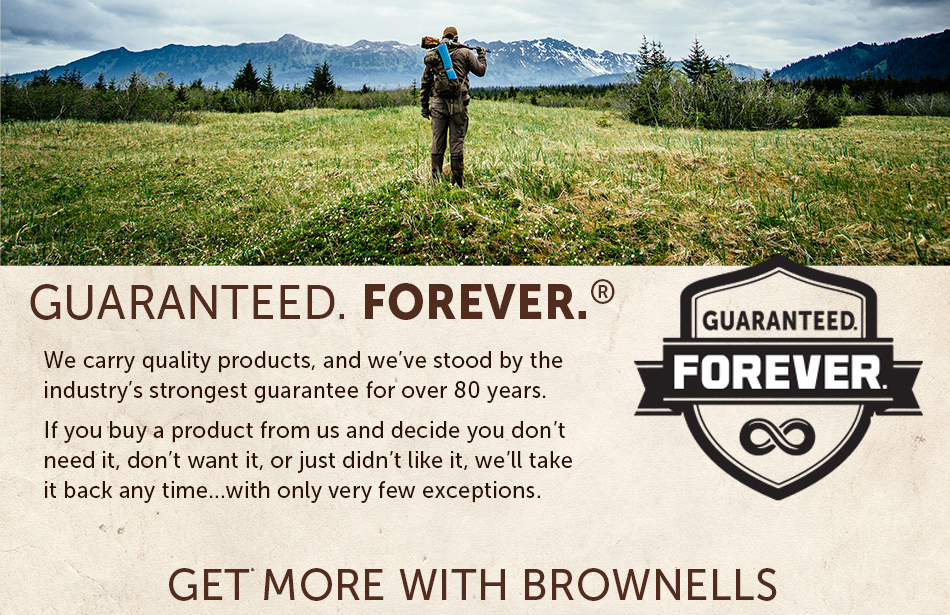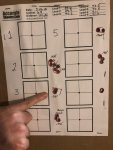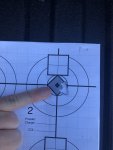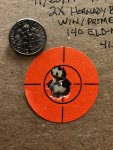Join the Hide community
Get access to live stream, lessons, the post exchange, and chat with other snipers.
Register
Download Gravity Ballistics
Get help to accurately calculate and scope your sniper rifle using real shooting data.

Install the app
How to install the app on iOS
Follow along with the video below to see how to install our site as a web app on your home screen.
Note: This feature may not be available in some browsers.
You are using an out of date browser. It may not display this or other websites correctly.
You should upgrade or use an alternative browser.
You should upgrade or use an alternative browser.
6.5 Creedmoor
- Thread starter Sportin Wood
- Start date
I always use the Nitride expander for .002" neck tension verified with pin gauges, as there is always spring back.I use this die

All SINCLAIR INTERNATIONAL Products for Sale Online - 236 Products
Brownells has 236 SINCLAIR INTERNATIONAL products for Sale Up To 91% Off including Reloading, Tools & Cleaning, and Gear.www.sinclairintl.com
with this mandrel ( or turning arbor as called). (NT26)
Arbors and Mandrels
21st Century Shooting, Reloading products, Reload, reloading ammo, 21st century, twenty first century shooting, shooting, gun arbors, mandrels, reloading, tools for reloading, front rest, f class, bench rest, short handle, arbor press, powder measure, bullet, bullet comparators, die base, shell...www.xxicsi.com
You want the neck turning arbor, as this will give you 2 thou neck tension. Get the expander if you only want 1 thou tension.
It measures the same as the carbide expander button in my Redding die.
Last edited:
I saw a guy on youtube literally shoot the same Lapua brass and reloaded it 20 times back to back with no annealing and just cleaned it by hand each time. No issues of accuracy deviation either. He could have gone more times but felt he had proven his point on how good Lapua was.Jumped on the Lapua brass train. How many reloads per brass should I realistically expect?
Thanks. Using H4350, Lapua and 140 berger hybrids, what should I start my load at increase by?
Thanks. Using H4350, Lapua and 140 berger hybrids, what should I start my load at increase by?
Start around 39gn. You'll probably end up around 41,5gn or 42,5gn, depending on pressure and velocity.
Start around 39gn. You'll probably end up around 41,5gn or 42,5gn, depending on pressure and velocity.
And increase by .3 as I did with my hornady brass?
And increase by .3 as I did with my hornady brass?
That depends on how you want do your load development- ,3 is a pretty safe interval but it takes a few loads to get up to max.
That depends on how you want do your load development- ,3 is a pretty safe interval but it takes a few loads to get up to max.
What would you recommend?
What would you recommend?
Head over to the reloading forum and search for load development methods. It all depends on if you're using a chronograph or just paper, and if you prefer one of the 'node' methods or something else. Sometimes I prefer using less components over more granularity, but I'm using a chronograph and a lab balance...
Yep getting consistent neck tension is important, especially if your brass is less than ideal, and near constant neck tension will reduce your ES and reduce vertical stringing at longer distances. Some batches of cheaper brass will measure between 13.0 thou and 15.3 thou from one case to the next. That is a lot. And if you measure neck thickness around the circumference of one particular case, you can easily see 1.5 thou differences, so sizing the outside of the neck will push all that inconsistency to the inside. That is not good for neck tension.
Btw: If you buy premium brass like Alpha, Lapua or Peterson, this becomes less of a problem.
Neck tension (and concentricity) generally improves by running a round object like a sizing button or a mandrel through the inside of the neck to get it as round as possible, and to achieve consistent ID by pushing the imperfections to the outside. I have several mandrel dies, but rarely use them now. I now use a Whidden non-bushing die with a full set of sizing buttons ground to specific sizes 1.0 thou apart. Superb piece of kit.
BTW: Concentricity has very little effect in a rifle that shoots 0.5” groups until TIR goes beyond 5-8 thou. So slightly degrading concentricity by 1-2 thou by pushing the variance to the outside is better than 100% variation in neck tension.
Most reloaders will use dry lube (graphite). Imperial makes a good one. Have not tried the liquid or wax varieties inside a case.
Btw: If you buy premium brass like Alpha, Lapua or Peterson, this becomes less of a problem.
Neck tension (and concentricity) generally improves by running a round object like a sizing button or a mandrel through the inside of the neck to get it as round as possible, and to achieve consistent ID by pushing the imperfections to the outside. I have several mandrel dies, but rarely use them now. I now use a Whidden non-bushing die with a full set of sizing buttons ground to specific sizes 1.0 thou apart. Superb piece of kit.
BTW: Concentricity has very little effect in a rifle that shoots 0.5” groups until TIR goes beyond 5-8 thou. So slightly degrading concentricity by 1-2 thou by pushing the variance to the outside is better than 100% variation in neck tension.
Most reloaders will use dry lube (graphite). Imperial makes a good one. Have not tried the liquid or wax varieties inside a case.
Just to add:
Neck turning can usually be avoided. It helps concentricity and neck tension, but only by a tiny bit. It may turn your 0.55” groups into 0.51” groups, and is not needed in a PRS or a hunting rifle. [In a BR rig it may well get you from 0.23” to 0.18” and can make the difference between being competitive or not.]
For most applications, it is easier to just buy premium brass and use as is.
Neck turning can usually be avoided. It helps concentricity and neck tension, but only by a tiny bit. It may turn your 0.55” groups into 0.51” groups, and is not needed in a PRS or a hunting rifle. [In a BR rig it may well get you from 0.23” to 0.18” and can make the difference between being competitive or not.]
For most applications, it is easier to just buy premium brass and use as is.
Last edited:
Alpha brass
CCI200
140g ELD
H4350
.060” jump
2.248” BTO
Initial work up with Alpha brass, cold shooter and cold bore 1st group. Nothing shot over .5”
I know only 3 rd groups but this many 3 rd groups without a significant flyer is good enough indication for me. Velocity at 40.2g was right at 2730
CCI200
140g ELD
H4350
.060” jump
2.248” BTO
Initial work up with Alpha brass, cold shooter and cold bore 1st group. Nothing shot over .5”
I know only 3 rd groups but this many 3 rd groups without a significant flyer is good enough indication for me. Velocity at 40.2g was right at 2730
Attachments
Same hereI’m using Redding Type S dies on all calibers I load for. I full length resize, decapping rod and expander removed. I use a bushing to set the out, mandrel to iron out the inside.
I am relatively new to hand loading and seeking some advice on choosing a load from my test data. The application is PRS-style shooting, 400-1,000 yards. I did a 70 round test (14 5-shot groups, 0.3 grain increments from 38.8 to 42.7).
Here is my rifle/environmental/load data:
Here is the shot data:


I was thinking either 41.2 grains based on what I have read, but any advice would be appreciated.
Here is my rifle/environmental/load data:
| Rifle | Savage 110 |
| Barrel | 24” 1:8” |
| Temperature | 45.86 |
| Humidity | 92% |
| Pressure | 30.11 |
| Altitude | 2,810 |
| Catridge | 6.5 Creedmoor |
| Bullet | Hornady ELD Match |
| Weight | 140 |
| Powder | H4350 |
| Charge | 38.8 to 42.7 |
| Primer | Federal 210 |
| Case | Sellier & Bellot (Once Fired) |
Here is the shot data:
I was thinking either 41.2 grains based on what I have read, but any advice would be appreciated.
Your 39.7 groups is the best! I'd load up several more groups of it and the 41.2 to see if they repeat the same results. Others may suggest increasing and decrease your charge by 1g on either side of those weights to see if you can further refine your groups.
Last edited:
ES on both sides of 40.9, as well as 40.9 are huge. Like, the largest on the graph. Nowhere in that area will the load be found.Groups on both sides of 40.9 look good.
Reading the graph 41.0g -41.3 looks good. Relatively flat. Velocity is right in a good zone at 2750-2765. With the groups it's important to focus on the amount of vertical you have and relative poi between them. The groups carry a similar poi @10-11 o'clock position. There certainly could be some you in there as well with the lateral spread. I'd load up 41.0-41.4 each tenth for five rds and see what that tells you, then refine the group on seating depth.I am relatively new to hand loading and seeking some advice on choosing a load from my test data. The application is PRS-style shooting, 400-1,000 yards. I did a 70 round test (14 5-shot groups, 0.3 grain increments from 38.8 to 42.7).
Here is my rifle/environmental/load data:
Rifle Savage 110 Barrel 24” 1:8” Temperature 45.86 Humidity 92% Pressure 30.11 Altitude 2,810 Catridge 6.5 Creedmoor Bullet Hornady ELD Match Weight 140 Powder H4350 Charge 38.8 to 42.7 Primer Federal 210 Case Sellier & Bellot (Once Fired)
Here is the shot data:
View attachment 7473944
View attachment 7473946
I was thinking either 41.2 grains based on what I have read, but any advice would be appreciated.
The low node looks good from 39.1-39.7 but it's a touch slow. Just my opinion. Hope it helps
Next step right now is to pick a charge weight and load up rounds for match over the weekend. After that will probably focus in on the node and further refine charge weight as some others are recommending.just trying to understand the ladder test. Chasm, what would be your next step?
Thank you. I will try that.Your 39.7 groups is the best! I'd load up several more groups of it and the 41.2 to see if they repeat the same results. Others may suggest increasing and decrease your charge by 1g on either side of those weights to see if you can further refine your groups.
Thank you. Yes that does help.Reading the graph 41.0g -41.3 looks good. Relatively flat. Velocity is right in a good zone at 2750-2765. With the groups it's important to focus on the amount of vertical you have and relative poi between them. The groups carry a similar poi @10-11 o'clock position. There certainly could be some you in there as well with the lateral spread. I'd load up 41.0-41.4 each tenth for five rds and see what that tells you, then refine the group on seating depth.
The low node looks good from 39.1-39.7 but it's a touch slow. Just my opinion. Hope it helps
https://www.snipershide.com/shooting/threads/working-a-load-and-no-change-in-fps.7041898/
Issue with my load workup.
Issue with my load workup.
Those of you running Type s bushing FL dies and lapua brass, what neck bushing are y’all using? I’ll be using lapua SRP brass with berger 140 hybrids
Lapua neck thickness is usually around 14.5 thou (average value) in my experience.
Fair warning: Redding bushings are not machined accurately and can be different by up to 2 or 3 thou from what is stamped on it. Just order a 287, 288 and a 289. One of them will be ‘right’. No point complaining about it, just the way it is. [Btw Wilson Machine & Gauge makes bushings that are labelled far closer to actual measurement, but they have some small error too, so just buy two to be safe.]
Brass Springback will change as the brass ages. Springback will tend to increase over time, forcing you to use a different bushing. This depends on how much your FL die works the brass, if you anneal every time, tight neck vs fat neck chamber etc.
Lapua makes premium brass and their pricing reflects that. Even though amongst the best available, it is not exactly prefect. There is about a 1 thou variation if measured at 6 positions around the circumference. That induces a small anount of runout, usually not enough to affect accuracy in a tactical rifle. There is about 0.5 thou variation in neck thickness from one case tot the next (average vs average), and that has a bigger effect on neck tension, which does matter if you want a low ES. Cull the worst ones. You will need a ball micrometer, or just pay close attention to seating force, use dry lube, then mark the very high and very low examples, if the problem repeats twice, chuck it.
Weight variation is usually good enough and you do not need to weight sort them. Weight delta can be 3.5 grains, but is often 1.5-2 gn. That increases ES only a little. If you want to be meticulous, then just cull the worst 2-5 cases - if you have exceptional accuracy expectation (groups below 0.3”). It is also worth running a Sinclair or similar mandrel through them, which then controls your neck tension more accurately.
IMHO opinion, neck turning does not gain you enough benefit if you use premium brass. I have tried both approaches, and all i gained from neck turning was the ability to skip the mandrel die resize. Accuracy was the same after I culled the repeat offenders that gave fliers or bad ES twice in a row.
Last edited:
If you’re checking the ID of your bushings with a pair of harbour freight calipers, ID trust the bushing more. If you’re using a 3 anvil bore mic, or gauge pins, you may have something valid to go on.
Gauge pins.
Main complaint is that the OD of the sized cases do not corresponds well with the bushing stamp. Tested on the same batch of AMP annealed Lapua brass, and the 288 bushing sizes less than the 289 bushing. Yellow TiN bushings....
Maybe i was just unlucky with Redding. Wilson did ok.
Last edited:
I don’t neck turn or weight sort bullets or brass. All rounds are seating within .001-.002” of each other and I consistently get .3-.4” groups. Chargemaster lite to powder and Redding non bushing fl sizer and micrometer seater.
Here’s a five rd group for example. .364”
I get better sd’s and es with my alpha brass but this group and many others are with my hornady brass. It shoots well and is repeatable.
Here’s a five rd group for example. .364”
I get better sd’s and es with my alpha brass but this group and many others are with my hornady brass. It shoots well and is repeatable.
Attachments
Anybody use large primer Lapua with H4350 and 140 hybrids? What type of grains you're getting for your load?
I was told the difference between Hornady and Lapua is probably going to be 1 grain less when matching velocities, but its not matching up or even close. I know the term 'compressed' gets thrown around, but not sure how that applies in this case.
I was told the difference between Hornady and Lapua is probably going to be 1 grain less when matching velocities, but its not matching up or even close. I know the term 'compressed' gets thrown around, but not sure how that applies in this case.
Well once I get some brass, bullets and my dies, I’ll be sure to let you know as I plan on using the 140 hybrids and lapua brass.Anybody use large primer Lapua with H4350 and 140 hybrids? What type of grains you're getting for your load?
I was told the difference between Hornady and Lapua is probably going to be 1 grain less when matching velocities, but its not matching up or even close. I know the term 'compressed' gets thrown around, but not sure how that applies in this case.
redding type S full length with .290 bushing..... which seems to work the best for me. I have .288, .289, .290, and .291... trial/error got me to the .290 bushing. Attached group was done with 2x fired Hornady brass. I have Lapua SRP brass as well and use the same .290 bushing. It has been my experience that the hornady primer pockets fail/get loose much sooner than the Lapua brass. I've had do throw out a few Hornady brass after only two firings.Those of you running Type s bushing FL dies and lapua brass, what neck bushing are y’all using? I’ll be using lapua SRP brass with berger 140 hybrids
Attachments
Last edited:
Jumped on the Lapua brass train. How many reloads per brass should I realistically expect?
I got between 25 and 30 reloads on Lapua SRP brass, shooting 140’s at 2730 fps, so mild pressure, dumped it due to nervousness about necks possibly separating. Mostly FL sized with a 2 thou shoulder bump. Sometimes neck sized them, which might perhaps have added some life.
Sectioned two cases: During neck turning i inadvertently cut a little too deep into the shoulder so it got thin at that spot. Operator error. Easy to avoid: Skip neck turning altogether, it makes very little difference if your final resizing step is to push a perfectly round object through the inside of the neck (mandrel or button).
Never actually got a neck to separate. I think 35 reloads was/is achievable in my setup. Primer pockets never opened up, but pretty sure that will be the eventual ‘failure mode’. If you run nuclear loads, you can destroy any SRP brass in 1 to 3 reloads.
All LRP brass will have lower life, but no actual experience with Lapua LRP brass. Nosler did 12 reloads, and i would guess Lapua LRP brass will have a similar life span.
I would recommend premium SRP brass for a 6.5 CM but there is a caveat: Some rifles tend to pierce primers if you run SRP brass, and then you have to get your bolt bushed. So maybe experiment with factory SRP ammo first.
Last edited:
I got between 25 and 30 reloads on Lapua SRP brass, shooting 140’s at 2730 fps, so mild pressure, dumped it due to nervousness about necks possibly separating. Mostly FL sized with a 2 thou shoulder bump. Sometimes neck sized them, which might perhaps have added some life.
Sectioned two cases: During neck turning i inadvertently cut a little too deep into the shoulder so it got thin at that spot. Operator error. Easy to avoid: Skip neck turning altogether, it makes very little difference if your final resizing step is to push a perfectly round object through the inside of the neck (mandrel or button).
Never actually got a neck to separate. I think 35 reloads was/is achievable in my setup. Primer pockets never opened up, but pretty sure that will be the eventual ‘failure mode’. If you run nuclear loads, you can destroy any SRP brass in 1 to 3 reloads.
All LRP brass will have lower life, but no actual experience with Lapua LRP brass. Nosler did 12 reloads, and i would guess Lapua LRP brass will have a similar life span.
I would recommend premium SRP brass for a 6.5 CM but there is a caveat: Some rifles tend to pierce primers if you run SRP brass, and then you have to get your bolt bushed. So maybe experiment with factory SRP ammo first.
I am sitting on about 15k worth of Federal 210M primers. So, any change to SRP brass won't be for quite a long time.
What was the powder weight for getting the 140 at that speed?
My best velocity/sd is at 42gn h4350, the burn rate is almost identical to rl16, I would think somewhere a little safe below max and work up in .5gn. Gonna be hard to find a node with 50 rounds and have leftovers. I started @39.5gn of the stated "41.5" max.Got some 140 accubond and have some rl16 on the way going to do a 10 shot ladder what charge should I start at? I've only got 50 of them or I'd do an ocw these things are like hens teeth right now
To follow up. I’m running SRP brass since I couldn’t get ahold of the LRP stuff. Probably gonna run somewhere between 42.8 and 43.2hr h4350 as it seems there’s a large node in there at 2800 FPS.Anybody use large primer Lapua with H4350 and 140 hybrids? What type of grains you're getting for your load?
I was told the difference between Hornady and Lapua is probably going to be 1 grain less when matching velocities, but its not matching up or even close. I know the term 'compressed' gets thrown around, but not sure how that applies in this case.
24” win tac bartlein barrel on an AIAXSA
Planning on doing a .5 ladder velocity test and find a flat spot then go .2 on either side. Then try to find about another 300 and load them up. That should keep me hunting for a whileMy best velocity/sd is at 42gn h4350, the burn rate is almost identical to rl16, I would think somewhere a little safe below max and work up in .5gn. Gonna be hard to find a node with 50 rounds and have leftovers. I started @39.5gn of the stated "41.5" max.
To follow up. I’m running SRP brass since I couldn’t get ahold of the LRP stuff. Probably gonna run somewhere between 42.8 and 43.2hr h4350 as it seems there’s a large node in there at 2800 FPS.
24” win tac bartlein barrel on an AIAXSA
That's good to know. I'm just shy of 42 running 2700.
Not at 10k off the lands. CBTO is 2.222Ah ok. Is it compressed
Well my chamber measures 2.232” CBTO. 2.222 is 10k off the lands for me. It’s a new barrel. I don’t know if it’s normal or not thoughDang my max CBTO is 2.210 is that a normal point for a newish barrel?
Similar threads
- Replies
- 10
- Views
- 537
- Replies
- 17
- Views
- 2K




